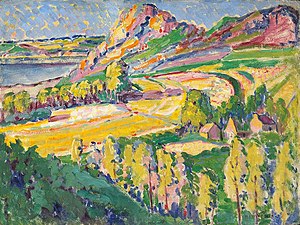Wikipedia community celebrates Public Domain Day 2016
On New Year's Day, Free Content advocates from all over the world celebrated Public Domain Day. This is because copyright protection ends on 31 December – in Europe and in many other countries seventy years after the death of the author. For several reasons, Public Domain Day is a holiday with many facets. On the one hand, the heirs (or often shareholders) of creators have to renounce on sometimes still quite lucrative rights. On the other hand, these works can now finally be used by anyone without limitations – e.g. on Wikipedia and on its sister projects like Wikisource.
The United States, however, decided not to celebrate until 2019. This is why no new content can be added to projects that adhere to U.S. law, like English Wikipedia and Wikimedia Commons. But let us turn to the jurisdictions that apply the "70 years post mortem auctoris" rule: Here, Public Domain Day 2016 affects all creators who died in 1945. In consequence, the list contains some rather peculiar personalities whose lives ended in the year of the liberation from the terrors of fascism and World War II. What does it mean for a biography to end in 1945?
Unfortunately, the first person to be named in this list is Adolf Hitler, who was a failed painter in Vienna before his horrible career as a politician and who wrote that famous manifesto during his time in prison. The German state of Bavaria has held the copyright for Adolf Hitler's works, including Mein Kampf, and used it to impede access to them except for special research purposes. Since January 1, anyone can spread these texts. In Germany and other countries, however, special laws continue to limit their circulation.
Luckily, we can mention a rather different work next: The Diary of Anne Frank. As published in a modified version by her father, Otto Heinrich Frank, in 1947 unter the title Het Achterhuis, it is still protected since Otto Frank, who died in 1980, is a co-author. The original parts by Anne Frank – and only in the Dutch original – have entered the public domain and are accessible on Wikisource. The diary is joined by the graphics and sculptures of Käthe Kollwitz, whose call for peace and humanity definitely made this Public Domain Day an event to celebrate.
And then there are the many other artists whose great works we remember this year and of whom we can only name a few: Painter Emily Carr and poet Paul Valéry stand aside David Lindsay, who wrote A Voyage to Arcturus, and Felix Salten, the creator of Bambi and – perhaps Josefine Mutzenbacher. The buildings of architect Jaume Torres i Grau can now also be used outside the limitations of freedom of panorama.
Also, three world-famous composers died in 1945: The music of Béla Bartók, Pietro Mascagni (Cavalleria rusticana) and Anton Webern could not be more diverse, but gravely influenced music history. It is thus important to note that Public Domain Day is a day when we remind ourselves that all creative endeavor is rooted in the creativity of others.
This is why copyright must have limits, not just in matters of time. Canada, China and many African and Asian countries even limit copyright to only 50 years after the death of the author, freeing the works of T.S. Eliot, Malcolm X, and "Blind" Willie Johnson in these jurisdictions. The Trans-Pacific Partnership, however, is now putting an end to this freedom, imposing a 70-year limit on all signatories.
A list of authors who died in 1945 can be found at 2016 in public domain. For a more comprehensive list, created using Wikidata, see Wikipedia:WikiProject Literature/2016 in public domain.
The author is a German Wikipedian.
 |
 |
 |






Discuss this story
Then we have copyright protection. I understand that the authors have every right to live off their works. But why does somebody that did nothing to make those works exist have a right to earn money from them? It is true that some heir promote the diffusion of the works of which they own a copyright, But even when it is not the case they are still entitled to that money, for something they didn’t do.
I recall a book by Enrique Jardiel Poncela. Excluding the title, the phrase that is written with the biggest typeset is a mention about his heirs being the owners of the copyright. Jardiel Poncela died in 1952. We are still paying to the heirs, who added nothing to the creative process. Anne Frank sadly died before she could publish her book; her father did a great effort to publish it. Due to this effort I find fair that he earn money from it. But what did Otto Heinrich Frank’s heirs did that entitles them to make money out of somebody else’s book, and in this case out of somebody else’s suffering?
I don’t care what laws and lawyers say about the legality of such a profit, I know it is not fair.
B25es (talk) 09:27, 17 January 2016 (UTC)[reply]